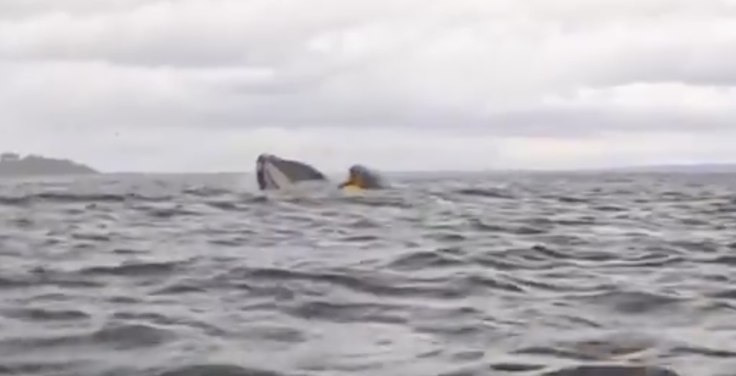What Happens If A Humpback Whale Swallows A Kayaker? Possible Scenarios Emerge After Dramatic Event Captured on Video
Humpback whales are filter feeders, meaning they consume small marine animals such as krill, plankton, and small fish

A kayaker off the coast of Chile recently experienced a terrifying moment that seems straight out of a nature documentary—a humpback whale briefly swallowed him before releasing him unharmed.
The rare and dramatic encounter, captured on video, has sparked curiosity about what might happen if a human ends up in a whale's mouth.
A Close Call in Chilean Waters
Last Saturday, Adrián Simancas was kayaking with his father, Dell, in Bahía El Águila near the San Isidro Lighthouse, a stunning yet treacherous stretch of water in the Strait of Magellan. While paddling in what appeared to be an inflatable kayak, Simancas was suddenly engulfed by a humpback whale as it surfaced with its mouth wide open.
Video footage recorded by his father captured the heart-stopping moment. The whale, likely feeding on fish and krill near the surface, inadvertently scooped up the kayaker. Seconds later, its massive tail broke the surface, and the animal dove deeper, releasing Simancas and his bright yellow kayak.
Though shaken, Simancas escaped without injury. His father, who remained calm throughout the ordeal, could be heard reassuring him in Spanish: "Stay calm, stay calm."
'I thought I was dead,' Simancas later told the Associated Press. 'I thought it had eaten me, that it had swallowed me.'
His fear didn't end when he resurfaced. The icy waters of the Strait of Magellan posed a significant risk of hypothermia, and he also worries about his father's safety. Fortunately, he was able to swim back to his father's kayak, and both returned to shore unharmed.
Can a Humpback Whale Swallow a Human?
While being swallowed by a whale might seem like something out of Pinocchio, experts say a humpback whale can't fully ingest a human.
According to Nature PBS, Humpback whales are filter feeders, meaning they consume small marine animals such as krill, plankton, and small fish by taking massive gulps of water and pushing it out through their baleen plates—comb-like structures that trap food inside their mouths.
Despite their enormous size (humpbacks can grow up to 16 metres long), their throats are surprisingly small. A humpback whale's throat is slightly larger than a human's, making it physically impossible to swallow a person.
Even in past cases where humans have ended up in a whale's mouth, the whale quickly realised its mistake and expelled the individual.
Similar Encounters: The Cape Cod Lobster Diver
This isn't the first time a person has been caught in a whale's mouth. In June 2021, a lobster diver off the coast of Cape Cod, Massachusetts, claimed he was "swallowed" by a humpback whale while diving. According to his account, he struggled inside the whale's mouth for about 30 seconds before being spat out onto the surface.
Marine biologists confirmed that while it was a sporadic incident, it was plausible. The whale likely engulfed the diver accidentally while feeding and ejected him immediately upon realising its mistake.
Why Do These Incidents Happen?
Encounters like these are not attacks but rather accidents. Humpback whales have no interest in eating humans, and their lack of teeth means they cannot bite or chew. When they feed, they lunge at schools of fish or krill with wide open mouths, often without precise control over what enters.
Given the murky waters of feeding areas, a small kayak or diver could easily be mistaken for prey. However, the whale's instinct to expel anything too large to swallow ensures that such incidents remain brief and non-fatal.
Are Humpback Whales Dangerous to Humans?
Humpback whales are generally gentle giants. Unlike orcas, which are apex predators, humpbacks pose no threat to humans unless approached recklessly.
However, their sheer size makes them potentially dangerous in close encounters. A fluke (tail) slap or an accidental collision could result in serious injury.
While direct interactions between humpbacks and humans remain rare, there has been an increase in whale strandings and ship collisions in recent years. In Chilean waters, for example, rising commercial shipping traffic has led to a growing number of whale deaths due to vessel strikes.
How to Stay Safe While Kayaking Near Whales
For adventure seekers who enjoy kayaking or diving in whale-populated waters, experts recommend the following precautions:
- Maintain a Safe Distance – Marine conservation laws often require vessels and kayakers to stay at least 100 metres away from whales.
- Be Aware of Feeding Areas – Whales engage in lunge feeding near the surface, which can be unpredictable.
- Avoid Startling Whales – Sudden movements or loud noises can cause a whale to react unpredictably.
- Stay Calm if an Encounter Occurs – In the unlikely event of an accidental close encounter, staying calm (as Simancas did) can help prevent panic-induced accidents.
A Remarkable Survival Story

Adrián Simancas's experience is a rare and dramatic encounter of the incredible power of nature. Though terrifying, his brief journey into the mouth of a humpback whale ended without harm—thanks to the whale's natural instinct to release anything too large to swallow.
While these encounters remain incredibly rare, they offer fascinating insights into the feeding behaviour of these magnificent creatures and remind us of the importance of respecting marine life while exploring the oceans.
© Copyright IBTimes 2025. All rights reserved.





















